
* A Distributed Proofreaders Canada eBook *
This eBook is made available at no cost and with very few restrictions. These restrictions apply only if (1) you make a change in the eBook (other than alteration for different display devices), or (2) you are making commercial use of the eBook. If either of these conditions applies, please check with a https://www.fadedpage.com administrator before proceeding. Thousands more FREE eBooks are available at https://www.fadedpage.com.
This work is in the Canadian public domain, but may be under copyright in some countries. If you live outside Canada, check your country's copyright laws. If the book is under copyright in your country, do not download or redistribute this file.
Title: Man on the Moon: A Picture Chronology of Man in Space Exploration
Date of first publication: 1969
Author: Anonymous
Date first posted: Mar. 12, 2021
Date last updated: Mar. 19, 2021
Faded Page eBook #20210325
This eBook was produced by: Stephen Hutcheson & the online Distributed Proofreaders Canada team at https://www.pgdpcanada.net

A PICTURE CHRONOLOGY OF MAN IN SPACE EXPLORATION
Collector’s Edition
1969
PUBLISHED BY
GALINA, INC.
8609 NORTHWEST PLAZA DR.
DALLAS, TEXAS 75225
TEXT COPYRIGHTED 1969
BY GALINA, INC., DALLAS
PHOTOGRAPHS COURTESY OF NATIONAL AERONAUTICS AND SPACE ADMINISTRATION
PRINTED IN U.S.A.

APOLLO 11 ON PAD 39A
The Apollo Program was designed to be the follow-on to the first manned satellite program of the U.S.
The National Aeronautics and Space Administration was established October 1, 1958, almost one year after the launching of Sputnik I by the Soviet Union. Within a week the United States’ first manned space program, later designated Project Mercury, was approved. The goal of this program was to develop the management and technological know-how necessary to put a man in space in earth orbit in order to establish man’s ability to survive and function in the heretofore unknown environment of space.
The Mercury objectives were accomplished during a program which included 19 unmanned and six manned missions. Mercury provided the United States with the beginnings of a competence in manned space flight as well as with an industrial base, ground facilities, and operational experience required for more advanced and complex space exploration.
Most of the emphasis in NASA was placed on the Mercury Project until the announcement of plans for Apollo was made at NASA Headquarters in Washington, D. C., on July 29, 1960.
At that time only one broad objective was stated for the manned space flight program: To provide the capability for manned exploration of space.
As envisioned, the advanced spacecraft program, Apollo, would be designed to allow man to perform useful functions in space. This spacecraft “should be capable of manned circumlunar flight as a logical intermediate step toward future goals of landing men on the moon and other planets.”
After Apollo was selected as an advanced manned program, a number of studies were conducted to determine the feasibility of various types of missions as well as different modes of accomplishing lunar landing.
Three primary methods for achieving the lunar landing mission were: (1) direct flight of a full-size space vehicle from earth to the moon and return; (2) launching separate major components into earth orbit, assembling them, and sending them as a single space vehicle to land on and take off from the moon; and (3) launching the whole spacecraft from earth to lunar orbit and landing a module on the lunar surface while the rest of the spacecraft remains in lunar orbit waiting for the lunar module to return and dock.
Finally, in July 1962, the third method, called lunar orbit rendezvous, was chosen after much time was spent in exhaustive study of the advantages and disadvantages of each of the proposed methods.

In the meantime, President John F. Kennedy challenged the Congress and the country to support a manned space program which would result in the United States landing a man on the moon and returning him safely to earth before 1970. This challenge, stated to the Congress in a personal appearance by the President on May 25, 1961, was accepted.
The difficulty of the goal to be achieved can only be understood when it is realized that at that time none of the basic essentials for such an accomplishment were available. No contractor had been selected to develop and build the spacecraft, the launch vehicle for the mission had not yet been selected or built, and, as mentioned before, the method of attaining the goal had not been determined. In addition, required facilities such as were necessary for launching and mission control were not in existence or in the planning stage.
Besides all this, Apollo was to be the largest and most complex technological program ever attempted by the United States or any other nation and required that management and manufacturing techniques be reevaluated and improved as necessary to carry out the tremendous research effort.
Many of these requirements were subsequently accomplished during the Gemini Program, which sent a series of two-man spacecraft into earth orbit during 1965 and 1966. However, the Gemini Program did not come into being until January 3, 1962, a year and a half after Apollo was initiated, when the need for an intermediate program to bridge the gap between the Mercury and Apollo programs was recognized.


SPACECRAFT
MERCURY • GEMINI • APOLLO

GEMINI VII SPACECRAFT FROM GEMINI 7/6 RENDEZVOUS
December 15, 1965
The required spacecraft was successively more complex as the manned spaceflight program progressed. For instance, in the Mercury spacecraft there were seven miles of wiring, in the Gemini spacecraft ten and a half miles, and in the Apollo command module alone there are fifteen miles of wiring. Additionally, the Mercury spacecraft consisted of 750,000 parts, the Gemini spacecraft of 1,320,000, and the command module of the Apollo by itself has about 2,000,000 functional parts.
The objectives of the Gemini Program, accomplished with striking success in two unmanned and ten manned Gemini spaceflights, were:
These objectives were successfully attained and the Gemini flight program was concluded with the landing and recovery of the Gemini XII spacecraft on November 15, 1966.
Great contributions to the manned lunar landing have also been made by the unmanned scientific programs, particularly the Ranger, Lunar Orbiter, and Surveyor programs, in which tens of thousands of photographs were taken of almost the entire surface of the Moon, indicating several likely landing sites for the Apollo astronauts. The unmanned Surveyor spacecraft, after soft landings on the Moon, each made a chemical analysis of the lunar soil. From the data thus obtained, it was determined that the lunar soil at the locations of those landings consists principally of basalt, the type of volcanic rock found on large areas of the earth, and contains traces of magnesium, aluminum, nickel, and other minerals. The data also revealed the presence of magnetic iron on the moon’s surface. Oxygen and silicon were shown to be the most common elements, as is true of the earth, and it was confirmed that the lunar surface is firm and could support the landing vehicle with no difficulty.
A manned lunar landing was chosen as a United States goal because it would require extensive research and development in almost every branch of science and technology, pushing back the frontiers of knowledge in these various fields. New materials and components had to be developed to function in the extreme cold and the extremely low pressures of outer space and at the extremely hot temperatures attained in rocket combustion chambers and on the outer surface of bodies reentering the atmosphere at high speed.

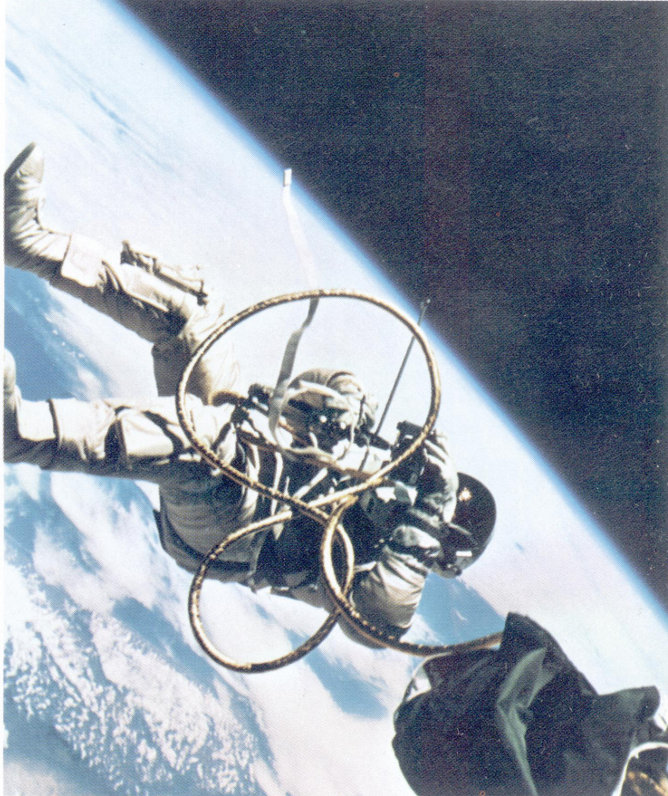
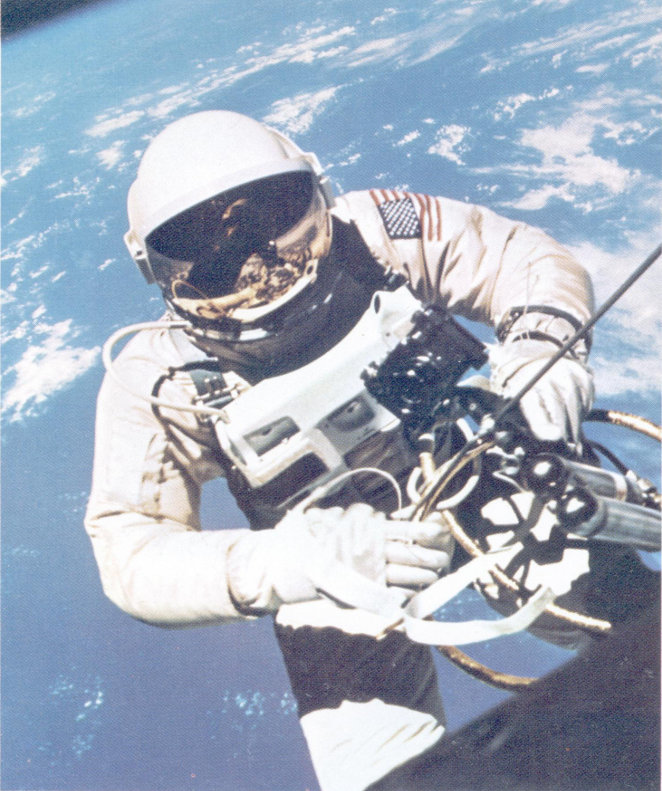
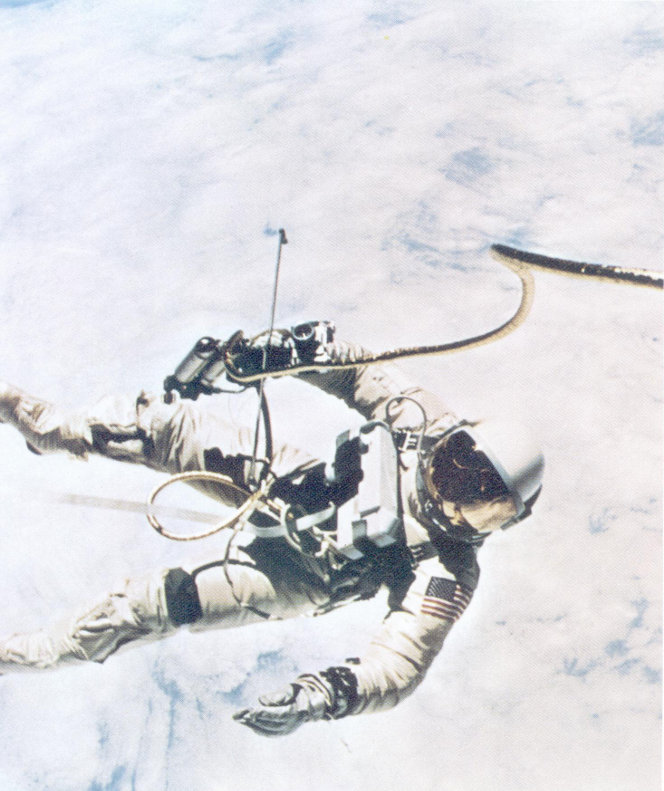
New developments would have to be achieved in propulsion, in electronics, in communications, in guidance and control techniques, and in computer techniques in order to accomplish the task. New information would have to be acquired in the life sciences, including information on the effects of the radiations encountered in outer space, the effects of long periods of weightlessness, and long exposure to a completely closed environment.
This new knowledge and experience in the space sciences and technologies would provide a sound basis for applying other new-found knowledge to the design of space vehicles for a variety of purposes such as space vehicles for scientific research, for communications systems, for meteorological observation, and for other potential applications.
Important was the fact that the developments in science and technology are transferable to other applications in an industrial society. The United States had repeated evidence in the history of the development of the automobile, the airplane, and the nuclear reactor of the transferability of developments in these fields to other industrial applications.
It was felt that development of space science and technologies needed in achieving the difficult goal of landing a man on the moon and returning him to earth would strengthen the entire industrial base and serve as insurance against technological obsolescence. The discipline of cooperation in a great effort could be the instrument of great social gain. Education would profit, and the money required in the effort would be spent in factories, workshops, and laboratories for salaries, for new materials, and new supplies, which in turn represent income to others.
The manned moon landing was chosen as a goal because no place other than the moon is so near in space for testing the equipment and the men for future space travel. The moon would be an excellent platform for mounting astronomical instruments, without atmospheric handicaps, and would be a relay point for communications and a refueling point for space travels.
It was felt that such a clear objective would give impetus, order, and efficiency to the space program.
The total Apollo Program is under the technical supervision of the Office of Manned Space Flight of NASA Headquarters.
Under the direction of that office, the Manned Spacecraft Center, Houston, Texas, has been the NASA installation responsible for the development of the Apollo spacecraft, for the selection and training of the flight crews, and for operational control of the mission from liftoff through recovery.
Launch vehicles used in the Apollo operational program, the Saturn I, the Saturn IB, and the Saturn V, were the responsibility of the Marshall Space Flight Center, Huntsville, Alabama.
Responsibility for the launch operations of Apollo spaceflights rests with the John F. Kennedy Space Center in Florida.
Computing and communications facilities of the Goddard Space Flight Center at Greenbelt, Maryland, to which both the Florida and Texas control centers are connected, have played a vital role in the Apollo Program as they did in the Mercury and Gemini Programs.

THE MOON AS SEEN FROM THE GEMINI VII SPACECRAFT
December 8, 1965
Other NASA Centers all contributed greatly in their specialized areas to the research and development necessary to the successful achievement of the Apollo Program objectives. Other government agencies also made important contributions. Of particular note was the work of the Department of Defense in the early launch vehicle research and development program and in the area of recovery operations of manned spacecraft.
More than 20,000 contractor industrial companies and 420,000 persons throughout the country participated in the Apollo Program through employment by the government, industry, and educational and research institutions.
North American Rockwell Corporation (formerly North American Aviation, Inc.) was awarded the principal contract to build the spacecraft’s command module, service module, launch escape system, and the spacecraft-lunar module adapter. Contract for the lunar module was awarded the Grumman Aircraft Engineering Corporation. The guidance and navigation system development contract was placed with the Instrumentation Laboratory of Massachusetts Institute of Technology.
The contractors for the Saturn V were: First stage (S-IC), Boeing Aircraft Company; second stage (S-II), North American Rockwell; third stage (S-IVB), McDonnell Douglas Corporation (formerly Douglas Aircraft Company); and the Instrument Unit, International Business Machines, Inc.
The overall lunar space vehicle cannot be described in simple terms or in a few words. Perhaps the best way to present the total configuration used in the lunar mission is to identify the major component parts.
The launch vehicles used in the Mercury and Gemini Programs did not have the thrust capabilities to lift the Apollo spacecraft into earth orbit or send it on its way to the moon, so the new Saturn family of greater-thrust launch vehicles were chosen for this purpose, the Saturn I, the Saturn IB, and the Saturn V.
The first stage of the Saturn V is called the S-IC stage. It is 33 feet in diameter and 138 feet tall. The second stage is referred to as the S-II stage. It, also, is 33 feet in diameter and is 81½ feet tall. The third stage is the S-IVB stage and is 58.4 feet high. It is basically 21.7 feet in diameter, although the lower interstage end expands to 33 feet in order that it may be mated to the S-II stage. An instrument unit is located on top of the S-IVB stage. It is three feet high and is 21.7 feet in diameter.
The Apollo spacecraft system is composed, primarily, of the spacecraft-lunar module adapter (including the lunar module), the service module, the command module, and the launch escape system. The combined height of these separate units is 82 feet.
The total vehicle for the lunar mission is 363 feet tall, in spite of the fact that the total height of the separate components is greater than that. Some of the parts overlap others in places.
The command module serves as the control center for any mission. It also provides the living accommodations for the three-man crew, having been designed to support the crew for periods of two weeks or longer.

Arabian Peninsula area, including Iran, Saudi Arabia, Trucial Oman, Muscat and Oman, Empty Quarter, Arabian Sea, and Persian Gulf, as seen from the Gemini XI spacecraft at an altitude of 250 nautical miles.
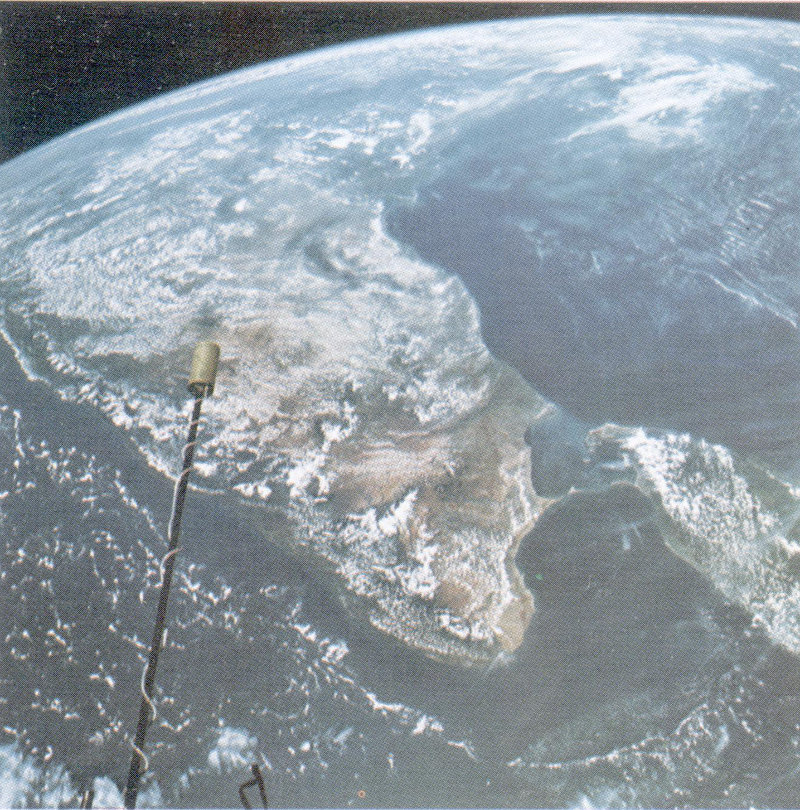
India and Ceylon, Maldive Islands, Arabian Sea, Indian Ocean. Bay of Bengal, looking north, as seen from the Gemini XI spacecraft at an altitude of 410 nautical miles.

Curvature of earth as seen from the Gemini XI spacecraft at an altitude of 670 nautical miles. Below is Indian Ocean, west of Australia, looking to northeast.
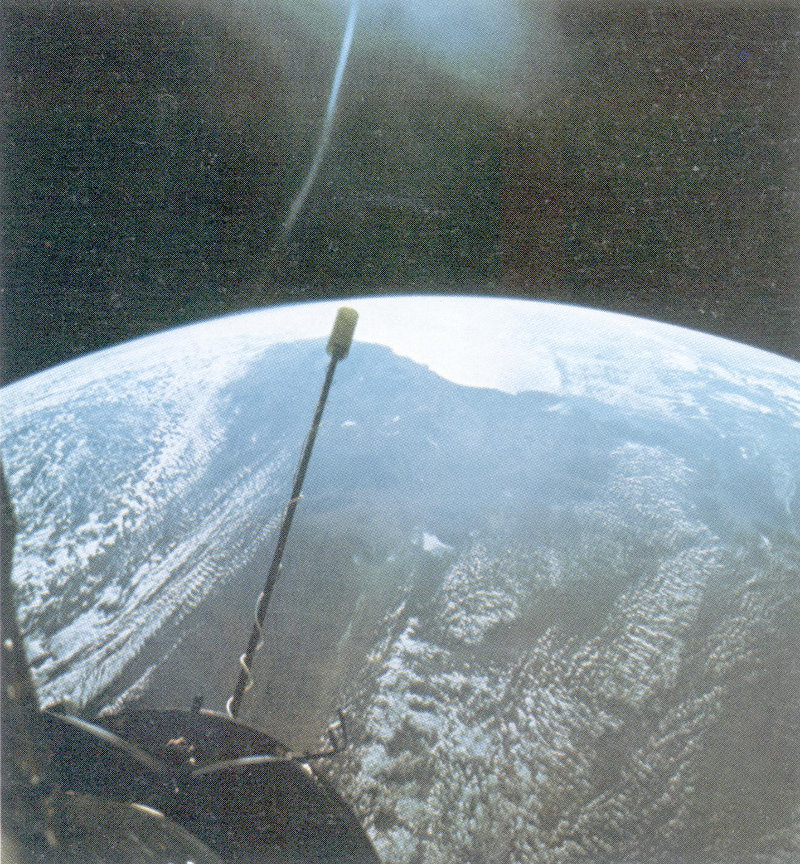
Western half of Australia, with coastline from Perth to Port Darwin, looking west, as seen from the Gemini XI spacecraft at a record-high altitude of 740 nautical miles.
This command unit is conical in shape, 12 feet high, 12 feet and 10 inches in diameter at the base, and weighs approximately 13,000 pounds. It has a habitable volume of about 210 cubic feet and is constructed primarily of aluminum alloy, stainless steel, and titanium. It is designed to provide a shirtsleeve environment for the crew with a temperature of about 75 degrees and a 100 per cent oxygen atmosphere.
The command module consists of two shells:
The inner shell is composed of aluminum honeycomb bonded between aluminum alloy sheets. The outer shell is composed primarily of stainless steel honeycomb between stainless steel sheets and is covered on the outside with ablative material to dissipate the heat which will be encountered during reentry. When completed the two shells are fastened together with a two-layer insulation in between. This construction is designed to make the command module as light as possible yet still rugged enough to stand the strain of acceleration during launch and return to earth, the heat of reentry, the shock and force of landing, and possible meteorite impact during flight.
Controls located in the command module make it possible for crew members to guide it throughout the mission. They also have equipment which gives them the necessary means for checking malfunctions in various spacecraft systems. Communication by means of television, telemetry, and radio will permit the astronauts to pass information from the spacecraft or from the lunar surface to earth.
The astronauts are in their couches during all phases of the flight when maximum g-loads will be encountered. At other times, the center couch is folded down to give crew members a small space in which to stand and move around while working. The Apollo couches are made of aluminum and titanium and padded with fireproof material. The couches are supported by six crushable honeycomb shock struts which will absorb the landing impact.
The service module is cylindrical in shape, 12 feet and 10 inches in diameter, and is 22 feet long. It, also, is constructed primarily of aluminum alloy, stainless steel, and titanium. The primary function of the service module is to house equipment not required in the command module and to house the propulsion system which will be used during the lunar mission to perform mid-course corrections and to inject the spacecraft into a trans-earth trajectory. The service module is jettisoned just before the crew orients the command module for the reentry phase of the mission.
The spacecraft-lunar module adapter (SLA) houses the lunar module during launch and earth orbit phases of the lunar mission, and joins the service module to the instrument unit of the launch vehicle. The SLA also houses the service module propulsion engine expansion nozzle. A cable in the adapter connects circuits between the launch vehicle and the spacecraft. It is shaped like a tapered cylinder and is 28 feet high. The SLA is 22 feet in diameter at the base and tapers to 12 feet and 10 inches in diameter at the top.

Apollo launch 11:03 a.m., EDT, October 11, 1968
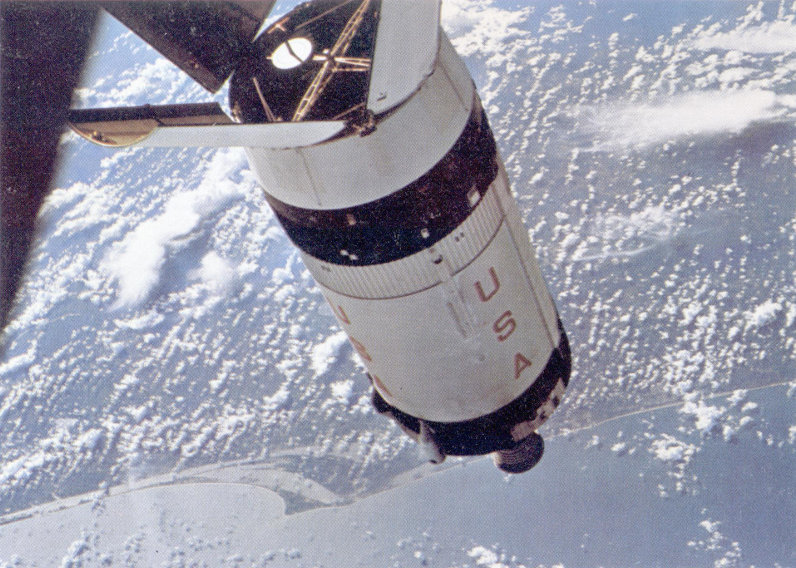
Apollo 7 rendezvous with second stage (S-IVB) over Florida
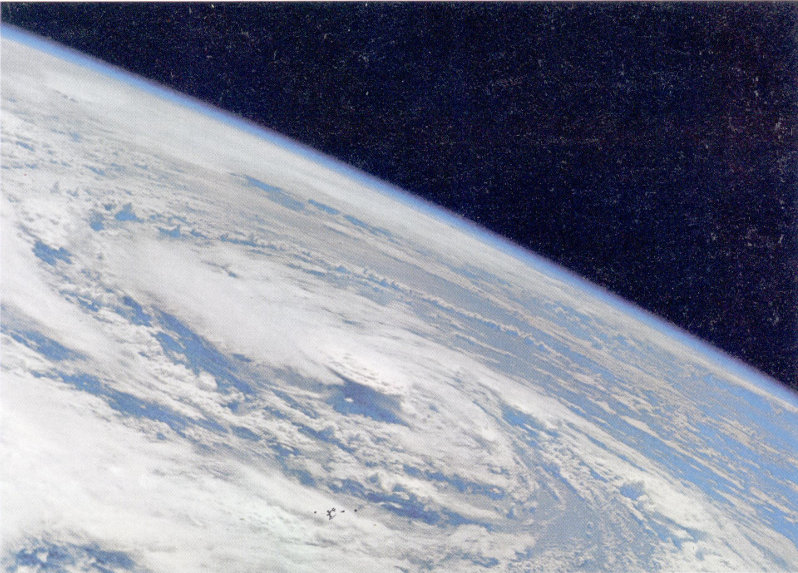
Apollo 7 views Hurricane Gladys
The lunar module (LM), is designed to carry two men from the orbiting command module to the lunar surface, to serve as a base of operations during the exploration of the moon, to provide limited living accommodations for the two crew members during the stay on the moon, and to return the crewmen to their scheduled rendezvous with the orbiting command and service modules (CSM). It consists of two main parts—a descent stage for landing and an ascent stage for takeoff from the moon.
Located in the SLA during the early phases of the trip, the lunar module has been called a bug-like cab on legs. Its height, with landing gear extended, is 19 feet and three inches, and its diameter across extended landing gear is 29 feet and nine inches.
The descent stage consists primarily of the descent engine and propellant tanks, the landing gear assembly, a section to house scientific equipment to be used on the moon, and extra water, oxygen, and helium tanks. It also serves as a launching platform for the ascent stage.
In addition to the crew compartment, the ascent stage houses the ascent engine and its propellant tanks, and all the crew controls. Most of the systems in the lunar module are essentially the same as those in the command and service modules including propulsion, environmental control, communication and guidance. Three windows give the crew visibility for both docking and lunar landing operations. Two of the windows are located in front of the crew position and are canted to provide sideward and downward visibility during descent and landing. The other window is located above the head of one crewman and is used when docking with the command and service modules.
The Instrument Unit (IU) is three feet high and 21.7 feet in diameter. It weighs approximately 4500 pounds. This unit is the nerve center of the Saturn V launch vehicle, containing the electric and electronic equipment needed for guidance, tracking, and origination and communication of the launch vehicle environmental and performance data. The IU also houses environmental and control equipment used for temperature control; and batteries and power supplies to furnish operating power for electronic equipment.
The Saturn I research and development flight program was originally planned for ten vehicles: four one-stage flights and six two-stage flights. The first seven flights were so successful that the development tests were terminated and the last three flights of Saturn I were assigned operational missions and carried Pegasus meteoroid technology satellites as payloads.
The Saturn I program proved the cluster design of the engine and tanks, the performance capability of two live stages, the guidance and control system, vehicle structures, and the vehicle/launch facility compatibility.
The Saturn IB was flown three times through 1967, twice involving major unmanned spacecraft missions. The first of these flights, on February 26, 1966, demonstrated the structural integrity as well as the compatibility of the spacecraft and launch vehicle.

THE EARTH FROM APOLLO 8.
DECEMBER 21, 1968
The space vehicle lifted off from launch complex 34 at Cape Kennedy at 11:12 a.m. The flight lasted 37 minutes and 19 seconds and the spacecraft landed more than 4000 miles downrange from the launch site.
The second Saturn IB test was conducted August 25, 1966. This vehicle, too, lifted off from launch complex 34 at Cape Kennedy. Liftoff was at 12:15 p.m. and the command module landed in the Pacific Ocean near Wake Island at 1:48 p.m. The results of the flight were satisfactory; major test objectives were to demonstrate structural integrity and compatibility of the spacecraft and the Saturn IB launch vehicle, to verify subsystems operation, and to evaluate the heat-shield performance during a high heat load reentry. A third flight of the Saturn IB, on July 5, 1966, carried a boilerplate spacecraft and was primarily designed to further qualify the launch vehicle.
The first manned flight of the Apollo program was scheduled for launch on February 21, 1967. Those plans were canceled, however, on January 27, 1967, when a flash fire in the command module of the Apollo spacecraft during a test resulted in the death of the prime crew for the mission and destruction of the spacecraft. The three astronauts who lost their lives in the fire were Virgil I. “Gus” Grissom, Edward H. White II, and Roger B. Chaffee. The fatal accident occurred during the late stages of a test in which the spacecraft had a 100 percent oxygen atmosphere.
As a result of that fire and its investigation by a board of engineers, design modifications were ordered and new safety features added. In all, over 5500 changes were made to the command module. About 1400 non-metallic items were replaced with new items made of nonflammable materials. Where flammable materials remained, they were shielded by metal.
The investigators blamed a worn or broken wire for triggering the fateful fire. Afterwards, many miles of spacecraft wiring were insulated with teflon wrapping. Stainless steel oxygen pipes replaced most of the more flammable aluminum pipes, and the joints of plumbing were treated so that danger from leaks caused from damage during spacecraft fabrication or testing was eliminated.
One of the modifications to the spacecraft was in the hatch. The new one would open in three seconds and was a great improvement over the previous crank-type hatch which took 90 seconds to open. In order to make all the changes deemed advisable after the fire, the first manned Apollo mission was delayed 19 months.
The next flight test was unmanned and the first test of the massive Saturn V launch vehicle as well. After an uneventful countdown on November 9, 1967, the launch vehicle which was designed to carry Apollo astronauts and their space vehicle on the lunar landing mission worked with admirable precision in its first test. Launch was only one second after its scheduled time. The launch vehicle placed a payload of 285,000 pounds into an orbit 118 miles above the earth.
The spacecraft’s propulsion system was burned later and the spacecraft sent to an elevation of 9767 nautical miles. The propulsion system was again ignited for more than four minutes in order to drive the spacecraft back into the atmosphere at a speed of 25,000 miles per hour—the approximate speed of spacecraft returning from a lunar mission. It landed in the Pacific Ocean as programmed eight hours and 37 minutes after liftoff. Examination revealed that the spacecraft had encountered reentry heat of more than 5000 degrees, while in the interior of the command module, the temperature had risen only ten degrees and had not gone above 70 degrees.

APOLLO 8 VIEW OF MOON
This test was followed by Apollo 5, with a Saturn IB launch vehicle carrying a lunar module which weighed nearly 32,000 pounds. This test which was conducted January 22, 1968, provided the first test of the lunar module in space environment. Within a short time after the spacecraft was inserted into earth orbit and then separated from the Saturn IB’s second stage. From that point on the lunar module responded to instructions which had been pre-programmed into the system as well as to new instructions transmitted from Mission Control Center.
The final unmanned flight test of Apollo was conducted April 4, 1968, when Apollo 6 was launched. The second Saturn V to be tested, it placed a payload of almost 94,000 pounds into earth orbit and, despite a few anomalies, performed satisfactorily enough when all the data was reviewed that NASA decided that the next Saturn V would be manned.
The size and complexity of the Apollo Program required that NASA introduce new methods during the launch phase. The result of studies conducted and the frequency of scheduled flights resulted in what has been termed a “mobile launch concept.”
This concept features the ability of assembly, mating, and checkout of the major components of the space vehicle in a protected environment, and transporting a flight-ready vehicle to the Merritt Island launch site. There, after propellant loading and final servicing, the launch is effected.
Key facilities at the Florida space installation, developed for use under this concept, were the Vehicle Assembly Building (VAB), Mobile Launchers, Transporters, Launch Sites, Mobile Service Structures, and the Launch Control Center (LCC).
The Vehicle Assembly Building (VAB) might well be classified as one of the wonders of the world and its description defies the use of other than superlatives. The VAB is the largest building in the world by volume—129,482,000 cubic feet. It has 343,500 square feet of floor space. It has a high bay area which is 525 feet high and covers an area 518 feet by 442 feet. It has a low bay area 210 feet high which covers an area 442 feet by 274 feet.
The high bay area has facilities which provide for the assembly and checkout of a Saturn V launch vehicle at the same time in each of its four bays. Access to each of these vehicles is provided by a number of work platforms in each bay which completely surround the vehicle. There are a total of 141 lifting devices in the VAB, ranging from one-ton hoists to 250-ton cranes.
The foundation of the Vehicle Assembly Building rests on 4,225 steel pilings which were driven 150 feet to 170 feet to bedrock. Each of these pilings is 16 inches in diameter.

ASTRONAUT DAVID R. SCOTT AT OPEN HATCH OF COMMAND MODULE, APOLLO 9 MISSION
A Mobile Launcher, consisting of a launch platform base and an umbilical tower provides the support for each space vehicle assembled in the VAB. This base, which later serves as a launch platform for the vehicle at the pad is 18,000 square feet in area. The base contains holddown arms for the launch vehicle’s first stage and houses required equipment such as computer systems, propellant loading equipment, propellant and pneumatic lines, electrical power systems and water systems. There is a 45-foot square opening through the base for rocket exhaust at liftoff.
The umbilical tower which is permanently positioned on the base platform is a 380-foot-high open steel structure. A crane which extends the total height to 399 feet is mounted at the top of the tower. The umbilical tower provides access platforms and support for propellant, electrical and communication lines. Two high speed elevators are centrally located within the structure of the tower. Each Mobile Launcher stands 445 feet and nine inches tall when standing on its mount mechanism at the pad, in the VAB or in the parking area, and weighs about 10.5 million pounds. Among major considerations in the design of the Mobile Launcher were crew safety and escape provisions.
One of the key components required to make the mobile concept work is a transporter which is able to move the massive mobile launcher with a launch-ready Saturn V from the VAB to the launch pad. (See photo on page 1.)
This transportation is provided by two giant transporters. These 5.5 million pound units also move the Mobile Service Structure to and from the launch pad. Each transporter is 131 feet long and 114 feet wide. Each of these vehicles moves on four double-track crawlers 10 feet high and 40 feet long. Every individual shoe on the crawlers weighs about a ton.
During operation the transporter is moved into the VAB, slips under the Mobile Launcher and raises the launcher and space vehicle. It then moves out of the VAB with its 11-million-pound cargo and transports it to the launch pad three-and-a-half miles away. The transporter may achieve a maximum speed of one mile an hour. During the trip which includes negotiating curves and a climb up a five per cent grade to the pad, it must carry its load in a vertical position at all times. In order to accomplish this the transporter is equipped with both manual and automatic leveling devices. It travels over a specially constructed roadway, 130 feet wide and eight feet thick.
During launch operations the Transporter, after depositing the Mobile Launcher and the Saturn V at the pad, returns to the service structure parking area about 7000 feet away. There it picks up the Mobile Service Structure and takes it to the pad.
This structure is a 402-feet high tower which weighs more than nine million pounds. It provides access for final connection of ordnance items, and provides access for fueling the hypergolics for the spacecraft, as well as serving other functional uses. This structure has five work platforms which close around the space vehicle including two which are powered to move up and down.
The electronic brain of the total launch complex is located just east of the VAB. It is the Launch Control Center (LCC) and its functional importance to the launch vehicle begins when the assembly starts taking place in the VAB. The LCC is a four-story building and it has four identical control areas which each consist primarily of firing room, computer room, mission control room, test conductor platform area, and offices.

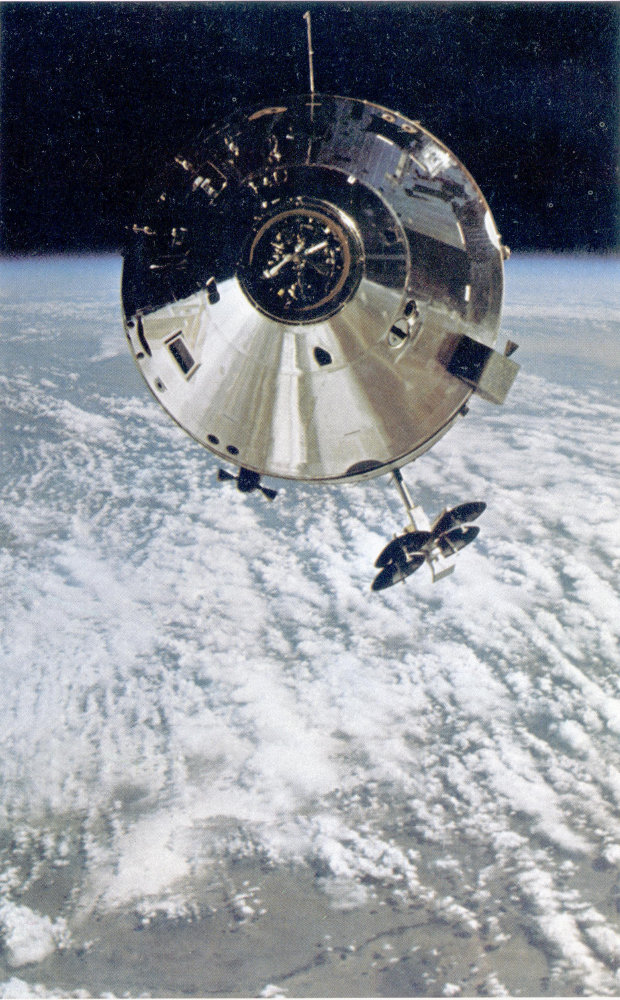
One of these control areas is assigned to a vehicle when the checkout and assembly process starts in one of the bays. This control area stays in direct contact with that specific vehicle from that time until it is launched. There are 15 display systems in each control area firing room with each system capable of providing instantaneous digital information. There are 60 television cameras positioned around the Saturn V and they transmit pictures on 10 channels. In addition, the LCC has several hundred communication channels which are operational and which enable launch personnel to be in voice contact with astronauts aboard the spacecraft.
The Manned Spacecraft Center in Houston, Texas, was chosen as the site for a new Mission Control Center, which became operational in time for the Gemini 4 flight in June 1965. It is from this building that flights are controlled from liftoff of the space vehicle through the recovery phase.
The Mission Control Center has five basic systems. They are the Display/Control System; the Real Time Computer Complex; the Communication System; the Command System; and the Simulation, Checkout, and Training System. These systems are designed to provide flight operations personnel with real-time data and reference data necessary for rapid assessment of any given situation during the course of a flight.
The Mission Control Center is a three-story building. In the operations wing, the Real Time Computer Complex and the Communications System are located on the first floor. These systems support the mission facilities and support offices located on the second and third floors.
NASA started gaining experience during the Mercury Project which would lead to the communications network required for the lunar landing mission. The Manned Space Flight Network (MSFN) used in Apollo is a worldwide extension of Mission Control Center’s monitoring and control capabilities.
Geographically, the network for Apollo is similar to that used in Mercury and added to and further used during the Gemini Program. As the requirements for Apollo became definitized, the network systems had to reach a new level of sophistication. There have also been extensive alterations to network equipment in order that greater volumes of astronaut and spacecraft information may be expeditiously handled. In addition, a higher degree of reliability has been incorporated into the network by adding redundancy where it was indicated desirable.
In order to come up with the answer for the demands of Apollo spacecraft weight, space limitations, mission duration, and distance, the Apollo Unified S-Band system was developed, with frequency ranging from 2270 to 2290 megacycles per second. VHF (very high frequency) was used for some communication links, such as those between the launch vehicle stages and the ground, between the command module and the lunar module, and between the spacecraft and an extravehicular astronaut. VHF and HF (high frequency) were used during recovery operations.

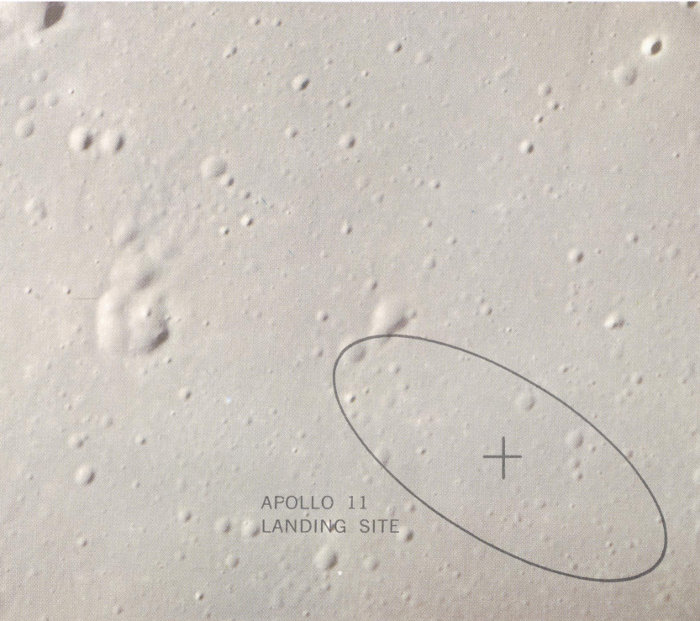
APOLLO 11 LANDING SITE
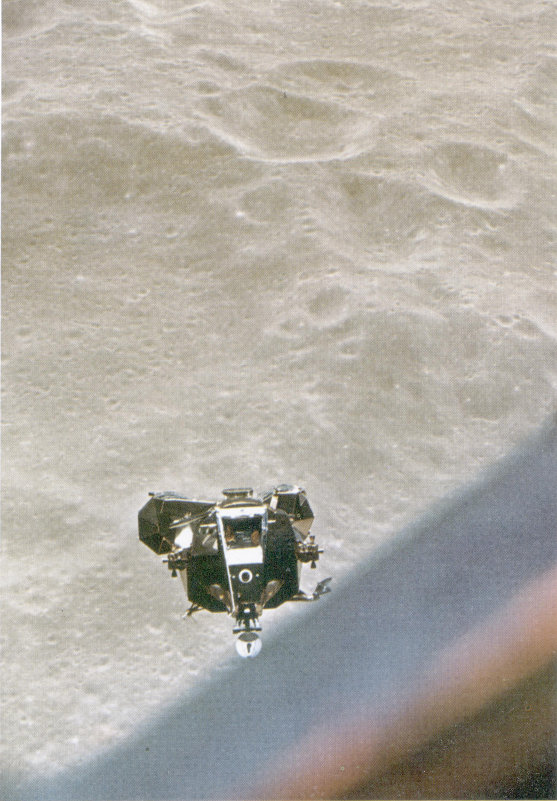
The Unified S-Band sites are located as required for different type duties and have special equipment to insure that such duties can be successfully carried out. For instance, 11 land-based stations are equipped with 30-foot diameter antenna systems; three others have 85-foot diameter antenna systems—the latter three are used for deep space communications work.
The Apollo Manned Space Flight Network consist of the antenna systems mentioned above, five Apollo ships; and instrumented aircraft. Three of the ships are equipped with 30-foot antennas and two have 12-foot diameter antennas. The aircraft are equipped with 7-foot diameter dishes in the nose.
The Lunar Receiving Laboratory (LRL) is the facility which was the receiving point for the astronauts, spacecraft, and lunar samples brought back from the moon. The LRL has four major functions: (1) distribution of lunar samples to the scientific community for detailed investigations following completion of the quarantine period; (2) performance of scientific investigation of the samples that are time critical and must be accomplished during the quarantine period; (3) permanent storage of a portion of each lunar sample under vacuum; and (4) quarantine and testing of the astronauts, the spacecraft, and the samples for unlikely, but potentially harmful, contamination brought back from space.
The main operational areas of the LRL as far as the lunar samples are concerned are the Sample Laboratory and the Vacuum Laboratory. The samples were initially received and taken to the Vacuum Laboratory where they were photographed, recorded, and divided among more than 100 scientists who were selected to perform scores of experiments of varied scope and magnitude. Prior to the distribution process some time-critical experiments were conducted.
NASA’s Office of Space Science and Applications in Washington, D. C., selected the scientists to work on this program. United States scientists selected were from 21 universities, two industrial firms, three private institutions, and 10 government laboratories. A number of experiments were awarded to more than a score of scientists from foreign countries, including England, Germany, Canada, Japan, Finland and Switzerland.
Almost two years after the last flight of the Gemini Program, Apollo 7 lifted off from Launch Pad 34 at Cape Kennedy, Florida, at 11:02 a.m. on October 11, 1968. Flying the three-man spacecraft for its first trial were spacecraft commander Walter M. Schirra Jr., command module pilot Donn Eisele, and lunar module pilot Walter Cunningham.

PRIME CREW OF APOLLO 11 MISSION—FIRST MEN TO LAND ON THE MOON
NEIL A. ARMSTRONG • MICHAEL COLLINS • EDWIN E. ALDRIN, JR.
The spacecraft and the second stage of the Saturn IB launch vehicle were inserted into an orbit of 123 × 153 nautical miles. During the 10.8-day flight a number of planned maneuvers using the service propulsion system were completed and, almost without exception, the spacecraft systems operated as intended. Following the normal deorbit, reentry, and landing phases of the flight the Apollo 7 spacecraft landed in the Atlantic Ocean, southeast of Bermuda after a trip which lasted 260 hours and nine minutes. The spacecraft and crew were taken aboard the aircraft carrier USS Essex. Apollo Program Director Samuel C. Phillips, in a post-landing news conference, said that the mission was 101 per cent successful. Then only two months after the successful completion of the Apollo 7, Apollo 8 lifted off from Kennedy Space Center at 7:51 a.m., on December 21, 1968. In the spacecraft, its commander Frank Borman, command module pilot James Lovell, and lunar module pilot William Anders anxiously awaited insertion into earth orbit, a spacecraft systems checkout procedure, and a final word from Mission Control Center that they were GO for a lunar orbit mission. Just more than 69 hours later the crew performed the maneuver which placed them into orbit around the moon and they became the first humans to see and photograph the dark side. Apollo 8 spent more than 20 hours in lunar orbit, most of it on Christmas Eve. During a television transmission during that time, beamed purposely to find millions of persons at home participating in the great event from afar, the commentary began: “I hope all of you back on earth can see what we mean when we say that this is a very foreboding horizon, a rather dark and unappetizing looking place. We are now going over one of our future landing sites called the Sea of Tranquility. Now you can see the long shadows of the lunar sunrise. For all the people back on earth, the crew of Apollo 8 has a message that we would like to send to you.” Then Anders, Lovell, and Borman read the first ten verses of the Book of Genesis. At the conclusion, Borman added: “And from the crew of Apollo 8, we pause with good night, good luck, a Merry Christmas and God bless all of you—all of you on the good earth.”
On the 10th orbit of the moon and while behind the moon, the Apollo 8 crew called upon their service propulsion engine again—this time to increase their speed to that necessary to escape the moon’s gravity and start them on their homeward path. While this was happening, many earth-bound people waited anxiously for Apollo 8 to pass the dark side of the moon and to report the result of the maneuver. Ten minutes after the engine firing the message came “Please be informed there is a Santa Claus.” Apollo 8 was homeward bound, on the right course, at the right speed. About 57 hours later Apollo 8 entered the earth’s atmosphere and following normal entry activities splashed down in the Pacific Ocean after a flight of 147 hours and 42 seconds. Again the spacecraft systems operated as intended.
Apollo 9 was the first manned mission involving the use of the lunar module. It was manned by spacecraft commander James McDivitt, command module pilot David Scott, and lunar module pilot Russell Schweickart. The launch had been scheduled for February 28, 1969, but was delayed three days because all three crewmen suffered from respiratory infections. However, on March 3 the Apollo 9 space vehicle was launched into an orbit of 102 × 103 nautical miles by the Saturn V Launch occurred as scheduled at 11:00 a.m.
After achieving orbit and completion of checkout procedures, the command and service modules were separated from the Saturn’s S-IVB stage, then turned around and docked with the lunar module. The docked modules separated from the S-IVB four hours and eight minutes after liftoff.

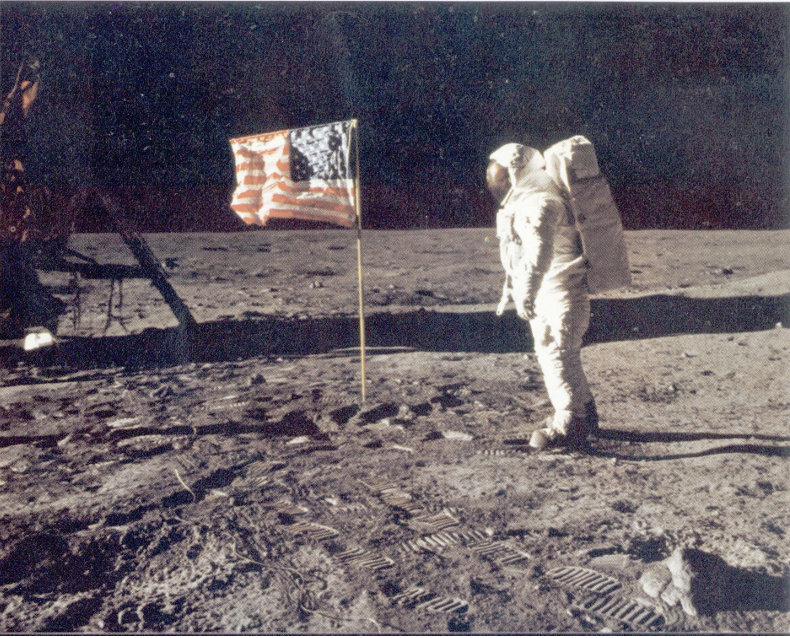
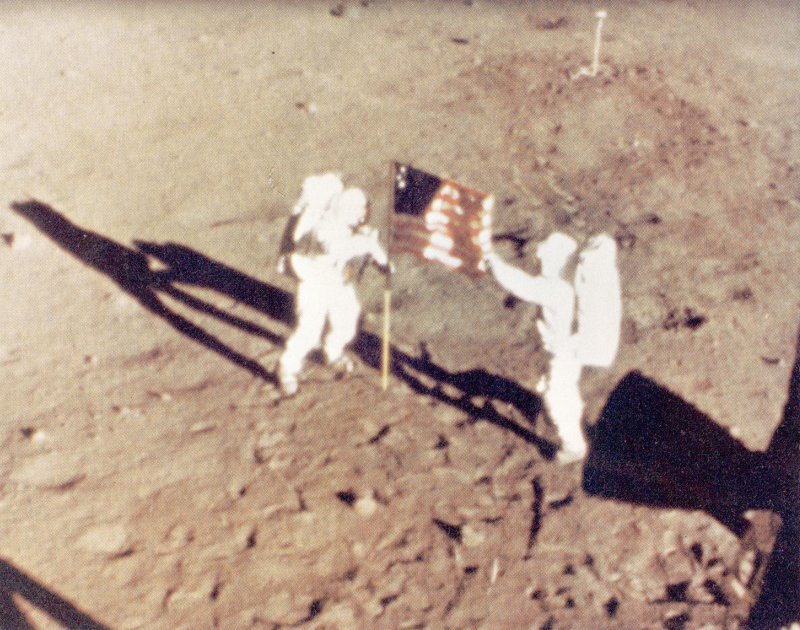
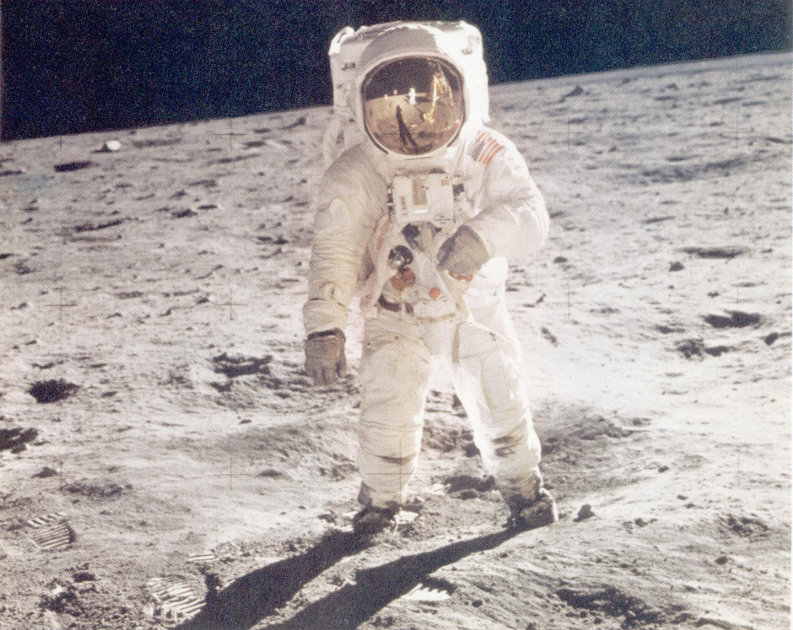

VIEW OF TRIESNECKER CRATER
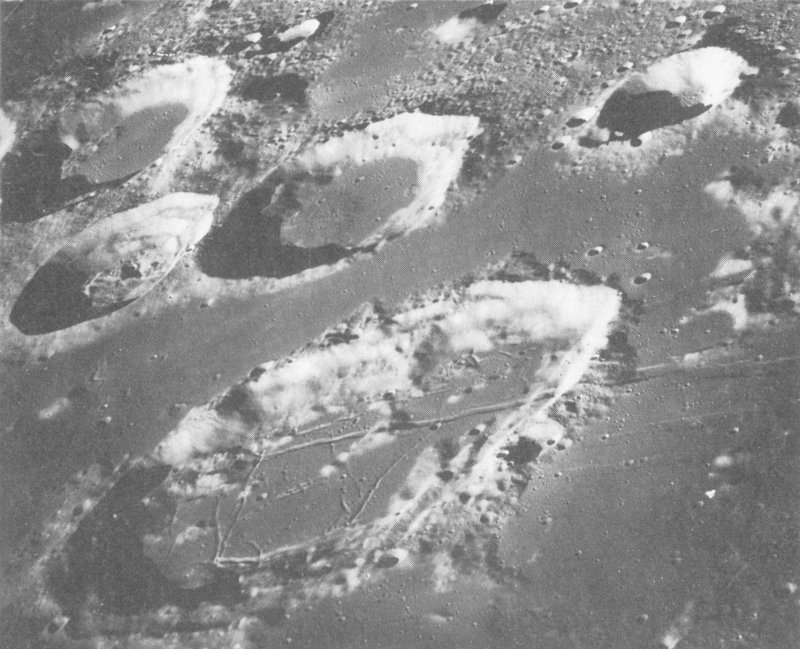
LOOKING SOUTH, LARGE CRATER GOCLENIUS IN THE FOREGROUND
During the next five days McDivitt and Schweickart transferred to the lunar module three times to perform various functions. During their first visit, after thoroughly checking out the module, the descent propulsion system was tested. During their second visit Schweickart went outside the lunar module for a 37-minute period of extravehicular activity. The highlight of the mission occurred the third time the two astronauts entered the lunar module.
On that visit they again thoroughly checked out all systems and after 93 hours of the mission had elapsed they separated the lunar module from the command and service modules and moved away. During this phase of the flight code names were used in communicating—the lunar module became “Spider,” the command and service modules, “Gumdrop.” During the next six hours a number of maneuvers had been made by Spider which resulted in it being 10 nautical miles below and 78 nautical miles behind Gumdrop. Spider then separated from its descent stage, fired the ascent propulsion system, and closed in to rendezvous with Gumdrop. The lunar module system had met the test.
Apollo 9 had a total flight time of 241 hours and 53 seconds with splashdown occurring in the Atlantic Ocean. Again all spacecraft systems performed nearly as planned, and, after examining the data, NASA gave the go-ahead for Apollo 10, a mission slated to perform much as Apollo 9 but to be performed in lunar orbit.
Apollo 10 had stated mission objectives of verifying the lunar module systems operation in the lunar environment, of checking the validity of crew activity schedules, and obtaining additional data on the effect of lunar gravity. The flight crew consisted of spacecraft commander Thomas Stafford, command module pilot John Young, and lunar module pilot Eugene Cernan.

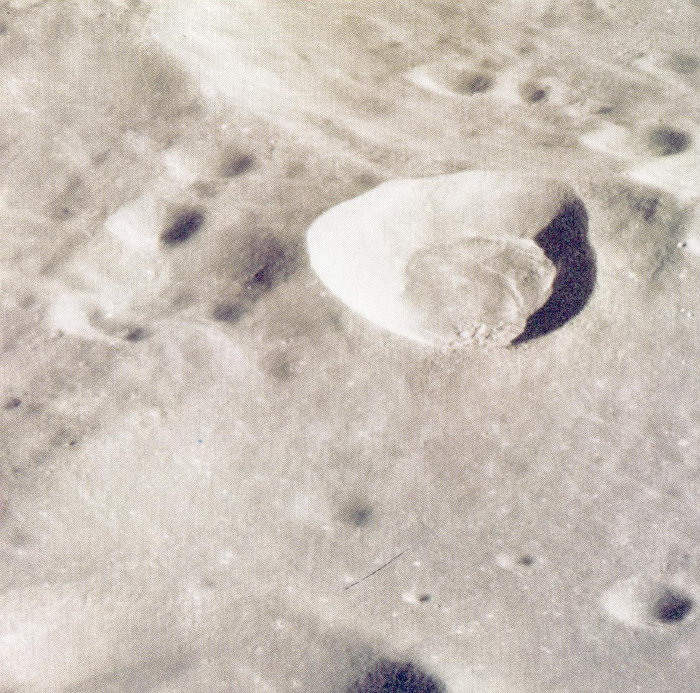

VIEW OF HYGINUS RILLE
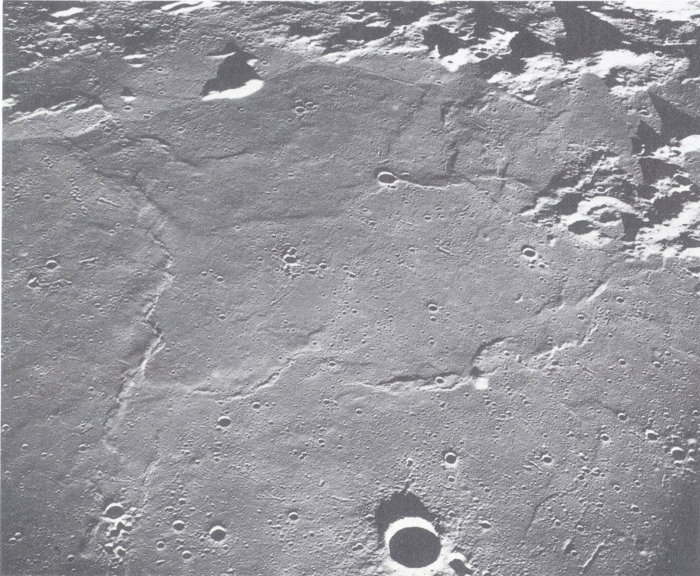
CENTRAL BAY AND BRUCE CRATER
Saturn V lifted the Apollo 10 payload off the launch pad at Cape Kennedy at 1:49 p.m. on May 18, 1969. After launch and insertion into earth orbit, the on-board systems were checked and two hours and 33 minutes after launch the S-IVB engines were re-ignited and the spacecraft placed into a translunar trajectory. About 27 minutes later the command and service modules were transposed and docked with the lunar module.
Forty minutes later another space first occurred—color television pictures. This was the first of a series of live color TV from Apollo 10 during the mission.
The spacecraft was inserted into lunar orbit about 76 hours after liftoff and the crew orbited the moon while performing a number of assigned tasks for some 61 hours.
For the purpose of identification of modules the crew used the code name “Snoopy” for the lunar module and “Charley Brown” for the command and service modules.
Stafford and Cernan transferred to Snoopy about 95 hours after liftoff and all systems were activated to prepare for the undocking which would occur nearly four hours later. Almost 100 hours after liftoff the lunar module was inserted into a descent maneuver which placed it into an 8 × 194 nautical mile orbit. During this period Stafford and Cernan got a close look at the proposed landing site for Apollo 11. The ascent stage engine was fired 103 hours into the mission and the rendezvous phase was initiated with the docking occurring more than three hours later.
Apollo 10 had an uneventful return trip and entered the atmosphere 191 hours and 48 minutes after launch. About 15 minutes later the spacecraft and crew landed safely in the South Pacific Ocean. The way had been cleared for the lunar landing mission!

ASTRONAUT ALDRIN WALKS ON SURFACE OF MOON NEAR LEG OF LUNAR MODULE, JULY 20, 1969
At 9:32 a.m., EDT, July 16, 1969, the Apollo 11 space vehicle was launched from Merritt Island, Fla., with an estimated crowd of 750,000 watching from the immediate area and hundreds of millions observing by a television network stretching to almost all corners of the earth. Inside the Apollo 11 command module were spacecraft commander Neil A. Armstrong, command module pilot Michael Collins, and lunar module pilot Edwin E. Aldrin, Jr. Man’s greatest adventure was under way!
The events following liftoff and during the first phases of the journey were so flawless that only one of four scheduled midcourse corrections were required during the trip to the moon.
Apollo 11 fired its service propulsion rocket and entered lunar orbit late Saturday. The following day, July 20, the command and service modules, named Columbia, were separated from the lunar module, Eagle, and Armstrong and Aldrin began their descent to the lunar surface. After the separation Armstrong remarked, “The Eagle has wings.”
The descent was uneventful until Eagle was near the surface; then Armstrong took control and moved the lunar module from a boulder-strewn landing site to a smoother place nearby.
Armstrong reported the landing by saying, “Tranquility Base here. The Eagle has landed.”
Less than six hours later the hatch of the lunar module was opened and Armstrong descended to the lunar surface. As he took that first step he said, “One small step for man, one giant leap for mankind.”
With that step Armstrong accomplished a dream of men throughout the ages.
Aldrin followed Armstrong to the surface about 20 minutes later. While on the moon, they set up a camera for live television transmission, set up seismographic and laser experiments, planted a United States flag, and gathered samples of moon soil and rocks to bring back to earth.
The stay on the lunar surface covered a 2½-hour period outside the lunar module.
The crew ignited their ascent engine following a 22-hour stay on the moon, then performed the necessary maneuvers to rendezvous with Collins and Columbia in parking orbit above the moon. After the transfer to the command module was effected, the lunar module was jettisoned and the Apollo 11 crew called upon the service propulsion system to start them on the homeward journey of their historic trip.

MARINER PHOTOGRAPH OF MARS
Mars—the next step.
October 4, 1957—Sputnik I, first man-made satellite, successfully launched by Russia.
January 31, 1958—Explorer I, the first United States satellite was launched.
August 15, 1958—Juno V (later named Saturn) booster development started.
October 1, 1958—National Aeronautics and Space Administration began operation.
November 5, 1958—Space Task Group (later became Manned Spacecraft Center) formed to manage the manned satellite program.
April 9, 1959—First group of astronauts for the manned space flight program selected.
July 28-29, 1960—Apollo was announced as a manned space flight program.
April 12, 1961—First manned orbital flight by Russian cosmonaut Yuri A. Gagarin.
May 5, 1961—First manned suborbital flight Of the United States—astronaut Alan B. Shepard, Jr., pilot.
May 25, 1961—President John F. Kennedy proposed to Congress that the United States accelerate its space program and land a man on the moon and return him safely to earth before 1970.
August 9, 1961—Instrumentation Laboratory of Massachusetts Institute of Technology was selected to develop the spacecraft navigation and guidance system.
October 27, 1961—The Saturn C-1 booster was successful in its maiden flight.
November 28, 1961—North American Aviation, Inc. was selected by NASA as prime contractor for the Apollo command and service modules.
December 7, 1961—NASA announced a two-man spacecraft program (Gemini) to provide follow-up flight experience to Project Mercury.
December 1961—The Saturn C-5 was selected as the Apollo launch vehicle for the lunar landing mission.
February 20, 1962—First manned orbital flight by United States—astronaut John H. Glenn, Jr., was pilot of three-orbit flight.
July 11, 1962—NASA announced that the Saturn C-1B launch vehicle would be developed to test the Apollo spacecraft in earth orbit missions. NASA also announced that lunar orbit rendezvous had been selected as the mode for accomplishing the lunar landing mission.
July 20, 1962—NASA announced that the Mission Control Center for Gemini and Apollo flights would be located at Manned Spacecraft Center.
September 1962—NASA announced the selection of an additional nine astronauts.
November 7, 1962—NASA announced selection of Grumman Aircraft Engineering Corporation to design and develop the lunar excursion module.
October 1963—NASA announced selection of an additional 14 astronauts.
April 8, 1964—The first flight test (unmanned) of the Gemini Program. The launch vehicle was a modified Titan II. Objectives were to check dynamic loads during the launch phase and to demonstrate the structural integrity of the spacecraft and launch vehicle.
March 22, 1965—Gemini 3 flight, three orbits, astronauts Virgil I. Grissom and John W. Young. First manned flight in Gemini Program.
June 3-7, 1965—Gemini 4 flight. First long duration flight ii (4 days) and first extravehicular activity (Edward H. White II was out of the spacecraft for 23 minutes). Flight crew—James A. McDivitt and White.
December 4-18, 1965—Gemini VII/Gemini VI missions. Gemini VII with astronauts Frank Borman and James A. Lovell Jr. as a crew set a space flight long duration mission record—330 hours and 35 minutes. In addition they and their spacecraft shared another first as they were the passive rendezvous target for Gemini VI, manned by Walter M. Schirra Jr. and Thomas P. Stafford. In addition, both spacecraft flew through a controlled entry to a predetermined landing point.
February 26, 1966—First unmanned flight test of the Saturn IB, designed to test the structural integrity and compatibility of the launch vehicle and spacecraft. The flight was designated Apollo-Saturn 201.
March 16, 1966—Gemini VIII, crew was astronauts Neil A. Armstrong and David R. Scott. First docking of two vehicles in space; first rendezvous of a manned space craft with an unmanned target vehicle.
November 9, 1967—Apollo 4, first launch of the Saturn V. Verified the mobile launch concept, the Saturn V as a transportation system for manned journeys to the moon, the Apollo’s ability to withstand the reentry heat, and the NASA tracking and communications network.
January 22, 1968—Apollo 5, launched by a Saturn V was placed into earth orbit carrying a lunar module. Both the ascent and descent propulsion systems Operated satisfactorily.
October 11-22, 1968—Apollo 7, first manned mission launched by a Saturn 18 on a 10.8-day flight. Crew: spacecraft commander, Walter Schirra; command module pilot, Donn Eisele; lunar module pilot, Walter Cunningham. To test spacecraft systems.
December 21-28, 1968—Apollo 8, launched by a Saturn V journeyed to the moon, made 10 orbits and returned. Crew: spacecraft commander, Frank Borman; command module pilot, James Lovell; lunar module pilot, William Anders. First time man had escaped earth’s gravity; first lunar orbit mission; first time man had viewed the back side of the moon.
March 3-13, 1969—Apollo 9, launched by a Saturn V launch vehicle carried a lunar module into earth orbit. Crew: spacecraft commander, James McDivitt; command module pilot, David Scott; lunar module pilot, Russell Schweickart. First extravehicular activity in Apollo, first time men exercised the lunar module as a separate space vehicle, and first rendezvous and docking between lunar and command and service and modules.
May 18-26, 1969—Apollo 10, also launched by a Saturn V, placed into lunar orbit. Spacecraft commander Thomas Stafford and lunar module pilot Eugene Cernan detached lunar module from spacecraft and descended to within 8 nautical miles of lunar surface in a test of lunar module systems in lunar environment. Command pilot John Young orbited the moon until their return, docking, and transfer into lunar module.
July 16-24, 1969—Apollo 11, the first manned lunar landing mission in history. Crew was astronauts Neil Armstrong, Michael Collins and Edwin Aldrin. Liftoff at 9:32 a.m., EDT, July 16; touchdown on the moon at 4:17 p.m., July 20. Armstrong’s first step on moon at 10:56 p.m., EDT, July 20. Armstrong and Aldrin stayed on surface until 1:09 a.m., EDT, July 21. Lunar liftoff at 1:54 p.m., EDT, July 21; splashdown southwest of Hawaii at 12:50 p.m., EDT, July 24.

[The end of Man on the Moon: A Picture Chronology of Man in Space Exploration by Anonymous]